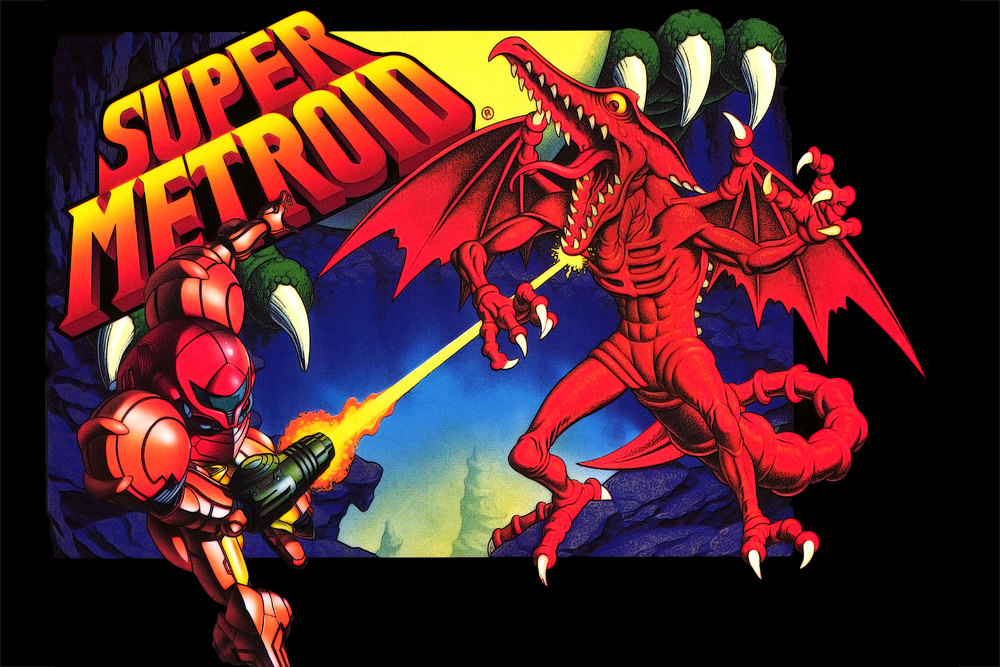I’ve mentioned it in articles in the past, but the Super Nintendo era of games is probably my favorite, and many argue one of the best generations for gaming ever. However, there is a game that doesn’t always get talked about in the same conversations as these 16-bit Titans, and I think it should be: and that’s the third installment in the Metroid series, Super Metroid.
Super Metroid is one of my favorite games ever made, and one that arguably doesn’t have a single thing wrong with it. The story is impactful, the gameplay is tremendous, the sound design is some of the best of any game in that generation, and the graphics and level design were ahead of its time. When Super Metroid was introduced to me, I was instantly enchanted and enamored and couldn’t put the game down until I had devoured it. And to this day, any time I blow out the cartridge and put it in my old school Super Nintendo, or any time I boot it up on an emulator, I get those same feelings of joy and wonder as I did the first time – hell, I still get chills when I hear the simple, yet hauntingly beautiful, opening music. So I decided to break down why Super Metroid is on my list of favorite games, and why I feel it’s stood the test of time as one of the greatest games ever made.
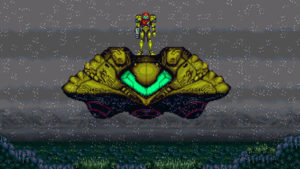
I’ll never forget how amped I was the first time I saw Samus arriving on the beautiful, yet dangerous, Zebes. (Nintendo)
Graphics and music were ahead of its time: I think an aspect of this has something to do with what developers were able to do with the SNES from a creative and artistic point of view, as many of my favorite games, from a visual standpoint, are SNES games – but Super Metroid really was a beautiful game to see and hear, and in my opinion was way ahead of its time and certainly had to have been an inspiration for many games to come. I remember the first time setting foot on Zebes, I really was kind of floored and in awe of the detail, the creatures, the landscape, and that doesn’t even include the magical soundtrack you’re treated to right away – and one of my favorite trivia tidbits around the music, is the composer for the game, Kenji Yamamoto, said he came up with the iconic theme music while humming it to himself riding his motorcycle. You would never think that a 2D side-scrolling game like this would be so fun and visually engaging, but man did Nintendo knock it out of the park – and it’s even more impressive, especially when you take into account my other reasons below, that this game was developed by a team of only 15 people!
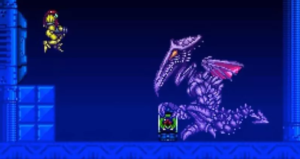
The vicious and deadly Space Pirate, Ridley, taking your Baby Metroid away. (Nintendo)
Moving and impactful story: There was really something special about what Nintendo was able to deliver with Super Metroid’s story, which directly followed up Metroid from the NES and Metroid II from the Gameboy. The truncated version of where we stand at the start of Super Metroid is Samus Aran, a bounty hunter, has returned to the planet Zebes in pursuit of Ridley, the leader of the Space Pirates, who has stolen a Metroid larva that imprinted itself on Samus in the previous game. Now back on Zebes, also the location for the first game, to start Super Metroid, Samus explores the massive new base that’s been built there, takes down the space pirates, finds her Metroid larva, which has grown to a massive size and attacks her. At the last moment, the larva remembers “oh hey, you’re basically my mom, right?” and leaves Samus alone.
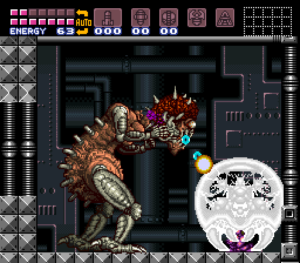
Metroid saving Samus from the evil Mother Brain… I’m not crying, you’re crying. (Nintendo)
Samus recovers, delves deeper into the planet and confronts the nefarious Mother Brain (again) and after one of the greatest roller-coaster boss battles, Samus finds herself near death against a seemingly unstoppable foe, only to have her Metroid larva sacrifice itself to fend of the Super Mother Brain and give you a brand new weapon: The Hyper Beam; a weapon capable of dispatching Mother Brain once and for all. As a kid I didn’t really understand the gravity of everything that had taken place in Super Metroid, and the games that came before it, but completing the game again when I was older I realized just how moving and deep this story really was. You don’t need a massive cinematic adventure to deliver a moving story, and Super Metroid proved that, and then some.
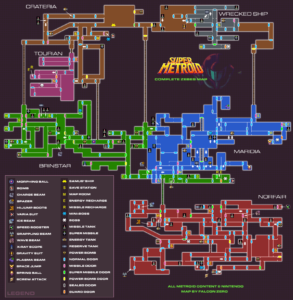
The map, and all its secrets, is extensive – oh how I wish I had this 20 years ago… (Nintendo)
Exciting and rewarding gameplay: This game really was one of the first I remember that had this level of complexity and ingenuity in level design. As with many of the more difficult Nintendo games of the time, you are thrust into an unforgiving and foreign world where you have to quickly fend for yourself and acquire abilities, weapons, armor upgrades, and more, to not only survive the onslaught of difficult, and varied, enemies, but to also simply enter doors. The Metroid series has always had a level of puzzle solving and needing to remember this one particular door in this one particular zone, and Super Metroid is no different. Some of the standard fare is still here, things like arm cannon, Morph Ball bombs, and missiles fending off foes and opening up doors, but you will also be using some new tools in your arsenal like the jump-capable Spring Ball, Space Jump to jump, well, a lot, and new tools like the Grapple Beam to get yourself around treacherous terrain. This time around, you also have a map, and not unlike games like The Legend of Zelda: A Link to the Past, as you explore new zones you can find special terminals where you can unlock the entire map, and all its secrets, for each zone. The gameplay for this game was truly tremendous, and easily one of the cornerstones for why it was so good – in fact, the side-scrolling 2D action was so good, and clean, that it’s still a smooth and enjoyable ride to take even today.
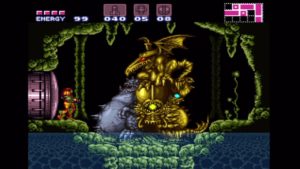
Seeing this statue for the first time, and realizing it was a hint at some of the trials to come, was very exciting. (Nintendo)
It didn’t hold your hand: If you’ve read my work in the past, you know I like a challenge. This aspect of Super Metroid is easily the simplest, the most straight-forward: This game absolutely did not, and still does not, hold your hand. Right from the get go the developers were like “Look, you know how this goes: here you are on this desolate planet with not much else aside from the suit on your back. Good luck!”. Very little is presented to the player in the way of a tutorial, and almost less is given to you in regards to a way to go or how to get there. You’re immediately met with areas you don’t have the capability of exploring yet, doors you cannot open, and some bad guys that can just flat out whoop your ass from the word go. And keep in mind, this game (and the other incredibly difficult early Nintendo games just like it) came out during a time when Gamefaqs and Google didn’t exist to guide you. In fact, unless you had the money for the ridiculously overpriced pay-per-minute call-in guides, or the pricey guide books, you were left to simply fend for yourself, using your wits, the map, and the note section the game’s instruction manual provided. It was a pretty special time to be a gamer, and some of the most enjoyable and fulfilling gaming experiences came during a time that it was me, and only me, that solved the game – and I loved that.
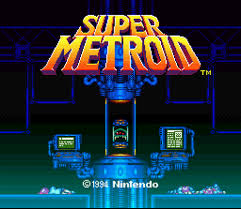
This opening screen, and its music, still give me chills to this day. (Nintendo)
Masterful extension of its predecessors: At the time Super Metroid came out, I can’t think of many other games that did such a masterful job extending not only the gameplay functions and mechanics, making them better with each iteration, but also doing such a phenomenal job of extending the story. The entire Metroid series may be able to be viewed as an entire storyline or story arch, but in my opinion, the most meaningful section of this game series’ storied history came from the NES Metroid, the Gameboy Metroid II, and the SNES Super Metroid. Not only was this just a perfect example of the games evolving, both visually and mechanically, but was also such an incredible, and impactful, extension of this impressive story.
